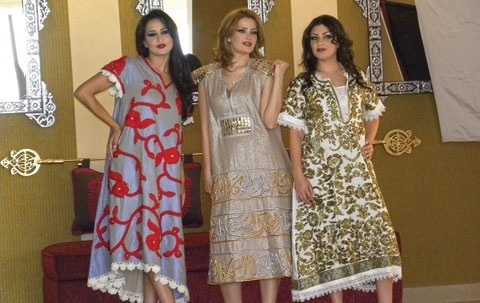KUWAIT TIMES

Traditional garments that are usually kept in wardrobes throughout the year make a grand appearance at Ramadan’s events: both at ghabqas and other get-togethers. Eid celebrations, however, remain the place to parade the traditional Kuwaiti outfit, known as dara’a (long dress). Known also as qaftan in Morocco or galabiya in Egypt, these traditional dresses are very typical in the Arab world. Many have varied designs, depending on their origin. In Kuwait, the dara’a has recently been adorned with more unique stones that make them stand out.
Najeeba Al-Qadibi, a Kuwaiti designer, started designing special types of dara’a called nashel – which she says are the best quality of traditional Kuwaiti women’s outfits. She launched her dara’a business three years ago and has already established her brand in the local market. What makes the designs of Qadibi special from others is that she is using different and higher quality textiles, which she imports from outside Kuwait. “I know there are many local dara’a designers, but they do not provide high quality designs,” she said, and explained that she imports the textiles for her outfits from Dubai, Turkey, Egypt and other countries. “In this way, I will have different pieces from others. Just a few of my textiles are from the local market,” Al-Qadibi said.
This is not all that makes her designs special, however. She also adds unique and expensive decorations from antique pieces brought from Turkey. “These pieces are from the Ottoman era in Turkey and they are really expensive. I’m the only one using this technique in my designs. Also, all of my designs are heavy and suitable for special evening occasions,” she explained.
All Najeeba’s designs are handmade. “I make five pieces of each design in sizes-medium and large. In case a Nashel is big, I can make alterations for the customers,” she says. In her workshop she gives the tailor the design she has drawn and he prepares a model. She prefers to work with linen, cotton and chiffon to suit the weather in Kuwait. “If a model looks good we then execute the final design. Because I am quite busy, I don’t take orders for individual designs, and I only do my collections annually,” she said.
2012 was a lucky year for Najeeba because she took part in five different exhibitions and expanded her business beyond Kuwait. “Currently, I’m also cooperating with stores in Saudi Arabia, Qatar and Dubai, which are selling some of my designs. I’m planning, in the future, to export my work to London, but this idea is still being developed,” she said, adding that she does not have a store in Kuwait. Due to the prevailing hot weather in Kuwait, most of her designs are suitable for the summer. “I usually don’t do winter nashels, however, there are some customers who like this type and demand it, so I’m adding some winter designs to my collections,” she added.
The dara’as and traditional costumes have changed with time and become more modern. She explained that constantly developing the style and adding new elements to the traditional costumes is what makes them original. “We recently changed jumpsuits to qaftan, so it’s in a more Arabic style. I also watch the international fashion shows and follow the latest fashion colors for each season,” noted Najeeba.






